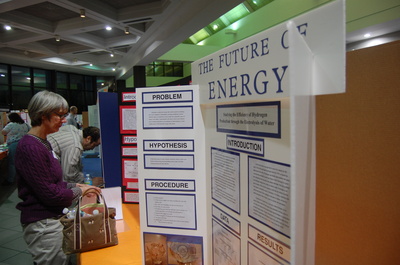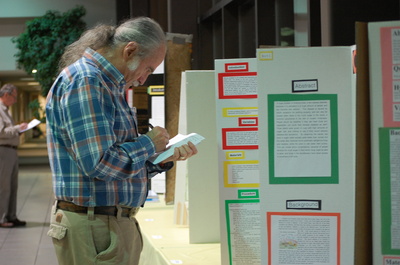The science of pimples: Students show off projects at WCC
Judging the 54th annual Southeast Michigan Science Fair is a lot more complicated than watching mold grow on bread. Some 150 judges gathered at Washtenaw Community College Friday night to evaluate close to 380 projects that addressed everything from radio wave propagation to pimples.

Karen Adams judges projects at the Southeast Michigan Science Fair at Washtenaw Community College.
Janet Miller | For AnnArbor.com

Cole Hawkins of the Michigan Botany Club judges projects at the Southeast Michigan Science Fair.
Janet Miller | For AnnArbor.com
For many of the judges, it’s a way to encourage the next generation of scientist, said Cinda-Sue Davis, science fair director and director of Women in Science and Engineering at the University of Michigan. “Participating in a science fair is a good predictor if a student will go into science or technology," she said.
The fair attracted 379 entries in the two divisions, one for middle school and the other for high school students, nearly doubling the number of participants from last year, Davis said.
The increase comes, in part, from Ann Arbor Pioneer High School hosting a school-wide science fair this year, which fed into the regional fair, Davis said. Students from five counties — Washtenaw, Livingston, Monroe, Hillsdale and Lenawee — participate in the Southeast Michigan fair, which is sponsored by U-M, WCC and southeast Michigan schools. It is affiliated with the Intel International Science and Engineering Fair.
While the projects are evaluated on criteria supplied by Intel - winning points on originality, scientific thought, thoroughness, accuracy, workmanship, clarity, and dramatic value - opinion also plays a role. “You also need to look at it holistically,” said Nancy Mathias, in her seventh year as a judge and a former medical researcher. “Does a project flow? Did they just copy reference material or is it integrated?
There are some projects that stand above the others, said Deano Smith, a physics teacher at Greenhills School and a member of the science fair’s operations committee.
A couple of years ago, one student created a computer imaging system that helped determine if skin lesions were cancerous, he said. “Almost every fair has one or two projects that are just phenomenal.”
Rob Sulewski, in his sixth year as a judge, said he remembers a middle school student who set out to find the dirtiest place in the student's school. Swabbing a variety of locations, including the bathroom, the student discovered that the telephone was the dirtiest object. “The project was well done and the results were surprising, but it all made sense,” said Sulewski, a pharmacist.
Jasmine Crumsey, a PhD student in ecology at U-M and in her fifth year as a judge, said she looks for the story behind what brought a student to their project.
“I look for how their project relates to their lives or to science, how they define a problem and an approach. I’m looking for a student to tell me how they came to care, the same way scientists explain why they do what they do to the public,” Crumsey said.
She remembers one student who researched the benefits different brands of yogurt had on patients who were taking antibiotics. The idea came after the student’s mother had given them yogurt when they were taking antibiotics.
Science fair entries reflects the times: “We’re seeing more and more computer science projects,” Davis said, “which means we need to get judges with computer science experience.” And there’s a growing interest in the environment and its impact on people, Crumsey said.
The judges’ work wasn’t done Friday night. Some returned this morning to interview the six finalists in the high school division and select Grand Award winners.
The top 10 winners are eligible to attend the Michigan Science and Engineering Fair in Detroit in April. First and second place Grand Award winners are invited to attend the Intel International Science Fair May 13-18 in Pittsburgh, all expenses paid.
The fair will be open to the public from noon to 4 p.m. today at the Morris Lawrence Building on the WCC campus.


Comments
DBH
Sat, Mar 10, 2012 : 4:07 p.m.
Thanks for a nice article. However, as I have done on more than one occasion on this site, I strongly request that an article or a notification be published BEFORE the event takes place so it would give those interested in attending more than a few hours lead to allow some planning. As it is, at this point I have plans that are now unchangeable and will not be able to attend, though I very much would have liked to have done so, and could have done so with a day or two advance notice.
DBH
Sun, Mar 11, 2012 : 1:44 a.m.
Thanks, @jcj, I think I have never noticed that before. Following the All Ages link does give you events for today and for several upcoming days. I am indebted to you for your pointing that out to me.
jcj
Sun, Mar 11, 2012 : 12:22 a.m.
I have to correct myself. The science fair is listed under the all ages tab.
jcj
Sun, Mar 11, 2012 : 12:20 a.m.
DHB Try checking the events calender at the top of this page. I do not know if anything was on their about the science fair. (probably not) but it does give some of the things going on. But I agree too many things that are reported on are after the fact or too late to attend.